Best international festivals to attend in December and January
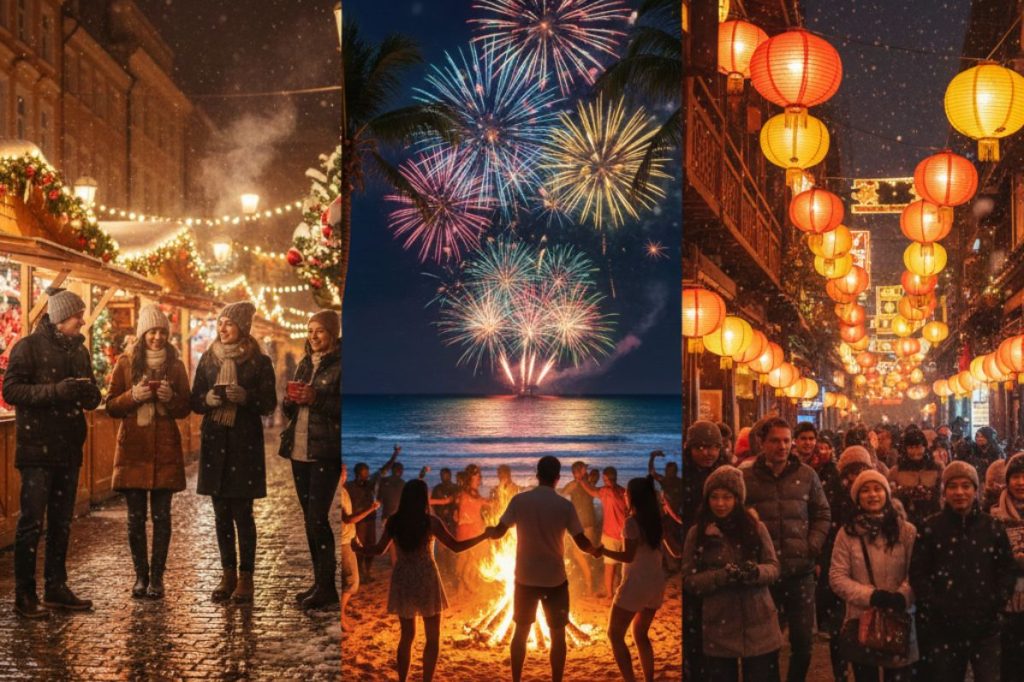
The last few weeks of the year are always filled with a touch of magic. Cities are ablaze with twinkling lights, and there is an intoxicating aroma wafting through the streets from roasted chestnuts and cinnamon being prepared at winter festival markets. Fireworks can be seen reflecting off the surface of the ocean and rivers, and people are gathering and celebrating together as if they were the best of friends. For many travelers, the festivities in December for the holidays and celebrations for New Year’s day are memorable not only for celebrating, but also for the memories created during the holiday season. The celebration period of December creates an atmosphere of music, culture, and excitement that attracts tourists and creates excitement in their daily lives. Whether you want to: Stroll through Christmas festivals & winter markets in Europe Dance on the beaches of Brazil or Thailand on New Year’s Eve Watch iconic fireworks in Sydney, New York, Dubai, or Singapore – this guide will help you find the perfect celebration. In Short December and January are peak months for Global festivals & Winter festivals across Europe, Asia, North America, South America & Oceania. Best picks include Christmas Markets in Europe, Amsterdam Light Festival, Rio New Year Festival, Sydney Fireworks, Times Square NYC, Sapporo Snow Festival Japan, and Montreal Winter Festival Canada. Ideal for culture lovers, families, couples, backpackers, party-goers & festival travelers. Book 2–4 months early to save on flights and stays. Layers and warm clothing essential for European winter; tropical festival travelers pack light. Why Travel for Festivals in December & January Travelers are more likely to remember a moment or experience than a location; this is true not only for large cities but also for small towns. Memories of emotions (excitement, joy) in relation to cities will last much longer than memories of simply where you were (geographical location). Additionally, experiencing the sights and sounds of an event (snow falling in a town, or the sounds of a large crowd cheering) has a much greater emotional impact than just tasting food or looking at buildings. Why winter festival travel is worth it Cities look completely transformed with lights, parades, art installations & fireworks Cultural festivals offer local food, music, traditions & immersive experiences Perfect vacation window for offices, schools & families Best season for snow holidays, skiing, and winter wonderlands Globally, Festival Tourism has become one of the fastest-growing travel trends for 2025–2026 – travelers are planning trips around events, not the other way around. For inspiration on destinations around this time, you may also explore ? Best Winter Destinations for Christmas & New Year Vacations Best International Festivals to Attend in December Below are the most iconic December festivals around the world – combining Christmas festivals, light festivals, seasonal festivals, and winter cultural celebrations worth traveling for. Christmas Markets in Europe (Germany, Austria, Czech Republic, France, Switzerland) If there is one image that defines December travel, it is wandering through snow-covered fairytale streets glowing with Christmas lights, sipping hot mulled wine, listening to choirs sing carols beneath gothic cathedrals, and browsing stalls filled with handcrafted ornaments and winter treats. Europe’s Christmas Markets are some of the most beloved Winter festivals in the world. Experience Highlights Handcrafted gifts, gingerbread, and festive street food Magical night markets & music performances Ice skating rinks & castle-lit towns Snowfall that feels straight out of a movie Best cities to experience Christmas Markets Destination Why visit Average December Temperature Munich, Germany Most traditional Bavarian markets -4°C to 4°C Vienna, Austria Classical music + imperial architecture 0°C to 5°C Prague, Czech Republic Most photographed Christmas market in Europe -2°C to 3°C Strasbourg, France Called “Capital of Christmas” 1°C to 7°C Estimated Budget Hotels: €90–€200 per night (₹8,500–₹18,000) Food & Entry: €20–€50 per day Full 1-week trip average: €900–€1,800 (₹85,000–₹1,70,000) What to Pack Thermal layers, fleece jackets, gloves, scarves, anti-slip winter boots Thermo flask & pocket warmers Travel Tips Weekday visits have fewer crowds and cheaper flight rates Pre-book popular market tours & chapel concerts For more festive inspiration, check? Top International Destinations for New Year Celebrations Amsterdam Light Festival – Netherlands A glowing wonder of art, creativity, and water – the Amsterdam Light Festival turns the city’s canals into a floating museum. Artists from around the world install giant illuminated sculptures and projections that come alive at night. Why Travelers Love It Magical nighttime canal cruises surrounded by floating light art Walkable festival paths with installations on bridges & waterfronts A photographer’s paradise Dates Late November – Early January (varies each year) Cost Festival canal cruise: €20–€35 (₹2000-₹4000) Accommodation: €110–€200/night (₹11,000-₹21,000) Weather 2°C to 6°C – cold & damp, carry waterproof layers Check our detailed guide? Amsterdam Light Festival Route, Tickets & Timings – Complete Travel Guide Winter Wonderland – London, United Kingdom One of the most thrilling Winter festivals in the world, held at Hyde Park. Experience Ice skating rink, carnival rides, circus shows Christmas village & food markets Giant observation wheel & music shows Budget £100–£200 (₹12,000-₹25,000 approx.) per day per travelerHotels begin at £120–£300/night (peak pricing) Weather 2°C to 8°CExpect rain → Pack waterproof & thermal wear. Hong Kong WinterFest A glowing skyline, Christmas lights on skyscrapers across Victoria Harbour, giant installations at Harbour City & Disneyland celebrations. Good for: Families, couples, shopping travelers Dubai Shopping Festival & New Year Fireworks Known for luxury shopping, concerts, drone light shows & the world’s most extravagant fireworks display near Burj Khalifa. Tips Book stays early – December = peak tourism Ideal warm-weather winter escape Spain’s December Festivals & Three Kings Parade – Madrid & Barcelona Colorful parades, fireworks, dances and gift-giving festivities. Rio de Janeiro New Year Festival – Brazil Millions dressed in white gather at Copacabana Beach to watch one of the world’s largest fireworks shows. Best Global Festivals to Attend in January New Year’s Eve at Times Square, New York City (USA) January celebrations often begin the night before – and few places deliver the energy and spectacle like
Best Winter Destinations for Christmas & New Year Vacations

The end of each year is filled with a variety of festive games, gatherings, and markets, and a huge amount of sparkle and fun! Christmas and New Year offer people a chance to get away from the normal routine and have unforgettable experiences, so it is more than just another holiday or event to share with friends and family. Travellers today want to experience unique moments – viewing fireworks against the backdrop of famous landmarks, building snow sculptures in snow-covered villages, dancing at midnight on tropical beaches, or drinking champagne beneath the Aurora Borealis (Northern Lights). The way we celebrate this time of year has changed; instead of staying home, we now focus on creating lifelong memories. Why People Love Traveling During Christmas & New Year For most people, the holiday season brings plenty of joy, excitement, and oneness with each other as they celebrate worldwide during this time of year. Many global cities are transformed into winter wonderlands, while millions of people will travel for romantic getaways, time with family, or exciting ‘bucket list’ adventures too. Celebrating holidays overseas is an exciting and liberating experience that allows you to expand your horizons – rather than putting up the same old, familiar Christmas tree, you’ll have the chance to check out the tallest Christmas tree in the world located in Dubai, enjoy the Rockefeller Tree lighting ceremony in New York City, or wander around snow-covered streets in Switzerland (around Christmas time) listening to carols. When you travel to celebrate a holiday, you are essentially celebrating the journey itself. Experience over celebration at home While staying home feels safe and familiar, celebrating Christmas and New Year abroad transforms the occasion into a once-in-a-lifetime experience. Travel gives you: New cultures and festive customs to explore Unique food, decorations, traditions & winter activities The chance to step out of routine and reconnect with loved ones Memories that feel richer than any material gift Today, experiences matter more than possessions – and December is the most meaningful time to invest in experiences. Travel Trends 2025 The global travel landscape is evolving rapidly, and the 2025 winter season is expected to be one of the biggest travel periods of the decade. Here are the most exciting travel trends shaping December 2025 vacations: ✦ Snow & Arctic travel boomTravelers are increasingly drawn to cold destinations like Finland, Iceland, Switzerland, and Canada to chase snowfall, Northern Lights, and winter wonder landscapes. ✦ Festival & event tourismInstead of regular sightseeing vacations, people plan trips around major events – New Year fireworks, Christmas markets, music festivals, theme-based experiences, and cultural shows. ✦ Digital Nomad slow travelMore professionals blend work + travel and choose longer itineraries across multiple destinations, especially during the holiday slowdown period. ✦ Experiential and immersive travelLocal cultural experiences, cooking workshops, festive parades, igloo stays, ski & snow adventure holidays, wine & Christmas market tours, and offbeat road trips are trending more than typical package tours. ✦ Multi-destination and multi-experience tripsTravellers combine 2 or more countries in one holiday – perfect for celebrating Christmas in one place and New Year in another. Why Plan a Combined Christmas + New Year Vacation Most people either travel for Christmas or New Year – but planning a single extended vacation that covers both festivals is now the smartest and most enjoyable trend. Here’s why: Longer holidays & time flexibility The end-of-year breaks, school holidays, and corporate closures create the ideal window to plan a 10- to 15-day vacation without taking excessive leaves. Best global weather December marks peak winter across Europe, UK, Canada, and parts of Asia – bringing postcard-perfect snow destinations. Meanwhile tropical beaches like Bali, Thailand, and the Maldives offer sunny escapes. Better value for money Instead of spending on two short trips separately, combine Christmas + New Year into one long adventure – better planning, smarter budget, lesser travel fatigue, and more experiences. Perfect for every traveler type Whether you’re a couple seeking romance, a family with kids, or a friends group wanting the biggest parties – extended festive vacations give everyone the time to enjoy themselves fully. Key Highlights Here’s what you’ll discover in this travel guide: The best places around the world to enjoy magical Christmas markets & spectacular New Year fireworks Destinations suitable for couples, families, party lovers, luxury travelers, and budget explorers Weather, budgeting, and travel tips for December vacations Detailed 7-10 day itineraries designed to celebrate Christmas & New Year together Local experiences, adventures, and must-attend events Options for multi-city and multi-country route planning Top 6 Destinations in the World for Christmas & New Year Vacations Below are six handpicked destinations-crafted to help you enjoy both Christmas & New Year in one epic vacation, with experience-rich itineraries, nearby excursions, markets, fireworks and seasonal events. 1. Switzerland & France (Zurich → Lucerne → Interlaken → Paris) Perfect for: Couples, winter lovers, first-time Europe travelers, Christmas markets, luxury holidays Ideal Trip Duration: 10–12 days Celebrate Christmas in the snow-filled Swiss Alps and ring in the New Year with fireworks under the Eiffel Tower – the ultimate magical winter route. Switzerland in late December turns into a postcard: frozen lakes, wooden chalets decorated with Christmas lights, fondue cafés, ski slopes, and scenic train journeys like the GoldenPass and Glacier Express. Begin in Zurich, exploring its traditional Christmas markets and Lake Zürich views; spend a white-Christmas in Lucerne or Interlaken, enjoying Mt. Titlis & Jungfraujoch snow activities; then travel to Paris for New Year countdown. Suggested Itinerary Dec 21–23: Zurich – Old Town walks, Bahnhofstrasse Christmas market, Rhine Falls day trip Dec 24–26: Lucerne / Interlaken – Christmas celebrations, Mt. Titlis ice cave, Jungfraujoch Top of Europe Dec 27–30: Scenic train to Paris, Disneyland Christmas Parade Dec 31: Eiffel Tower fireworks & Champagne cruise on the Seine Seasonal Highlights ✔ Magical snowy Christmas & European festive charm✔ Luxury winter trains & alpine adventures✔ Iconic Paris New Year celebration 2. New York + Niagara + Washington DC (USA East Coast) Perfect for: Families, city lovers, festive
Top International Destinations for New Year Celebrations
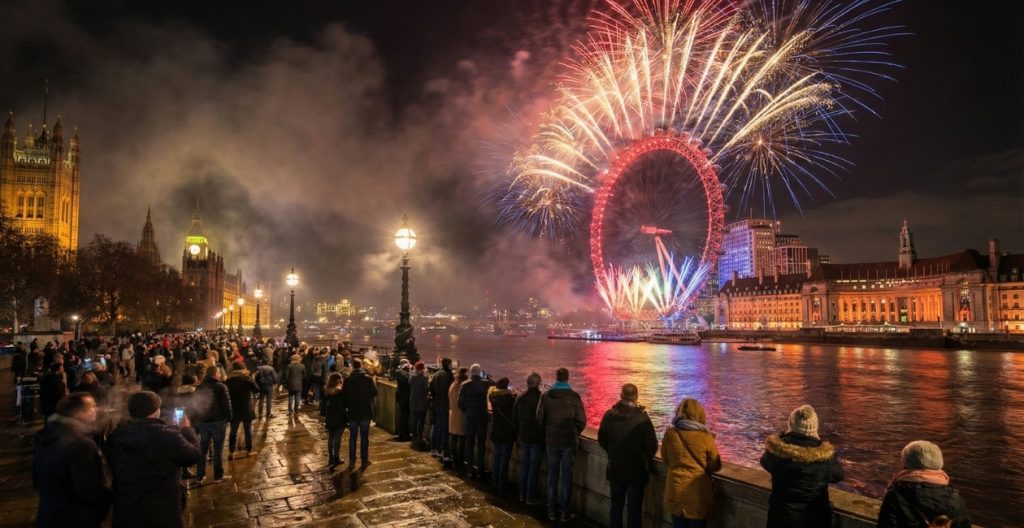
Across the globe, many of us around the world celebrate New Year’s Eve as one of our most cherished and exciting dates each year. This is the date filled with celebrations, fireworks, countdowns, large crowds of people celebrating, and amazing memories. If you are thinking about planning on going away for New Years this coming season, this is a perfect opportunity to travel to some of the most famous and best cities or holiday spots in the world. No matter where you are traveling to (Australia, America, Asia) there are astounding displays of fireworks being held in cities like Sydney, Dubai, etc., as well as romantic date nights in locations like Paris and the Maldives, as well as festive street parties being held in locations like Bangkok and New York City – the ways in which we all celebrate the New Year are limitless!! If your travel plans are for a luxury getaway, budget-friendly trip away for New Years, a family vacation away for New Years, or a Romantic Vacation away to Celebrate New Year’s, there are a ton of amazing options out there for you! International travel is becoming more and more common due to trends related to international tourism and the growing number of countries that are now offering the ability to enter their country with a quick and easy visa as well as their festive travel offerings/travel packages will contribute to making international travel for New Year 2025 one of the top Holiday Choices as well. Why Celebrate New Year Abroad? Celebrating New Year outside India is not just a vacation – it’s an experience packed with energy, culture, emotion, and celebration. Here’s why travellers are choosing global destinations: Iconic Fireworks & Countdown Events – Burj Khalifa, Sydney Harbour, NYC Times Square, London Thames Beach Parties & Warm Winter Destinations – Bali, Phuket, Maldives, Singapore Romantic New Year Getaways – Paris, Santorini, Maldives, Swiss Alps Family-Friendly Celebrations & Festivals – Singapore, Dubai, Sydney, London Unique Cultural New Year Traditions – Japan, Spain, Hong Kong, Vietnam World-Class Nightlife & Parties – Bangkok, Amsterdam, Miami, Rio Better Travel Accessibility – More direct flights, travel packages, visa-on-arrival options Traveling abroad for New Year gives you a chance to begin the year in a new place, with new memories and inspiration – perfect for couples, families, solo travelers, and groups alike. Travel Trends for New Year 2025 Based on global travel forecasts and booking patterns: International New Year travel is expected to rise by 30–40% in 2025, especially among young Indian travellers and families Dubai, Singapore, Sydney, and Bali are among the top trending choices due to availability of Visa-on-Arrival / easy visas Affordable New Year destinations like Vietnam, Sri Lanka, Nepal, and Turkey are gaining huge popularity People are booking earlier than ever – 4–6 months in advance to secure flights and hotels at good rates Experiential trips (cruises, rooftop countdown parties, concerts, cultural festivals) are becoming more desirable than traditional travel Demand for customized and group holiday packages is rapidly growing, making New Year 2025 one of the biggest travel seasons Key Highlights Best global cities for New Year fireworks: Dubai, Sydney, New York, London Warm winter & beach celebrations: Bali, Maldives, Phuket, Goa Best places for nightlife & parties: Bangkok, Amsterdam, Miami Romantic escapes for couples: Paris, Santorini, Maldives Family-friendly destinations: Singapore, Dubai, Sydney Budget picks: Vietnam, Sri Lanka, Nepal, Turkey Book 4–6 months early for best prices Choose based on weather, visa, budget & travel style Top 10 International Destinations for New Year Celebrations 1. Dubai, UAE – The World’s Most Iconic New Year Fireworks Dubai remains one of the best international destinations for New Year celebrations, famous for its larger-than-life fireworks at Burj Khalifa, Palm Jumeirah, and Burj Al Arab. The entire city turns into a festival ground with concerts, luxury cruises, beach parties, desert gala nights and spectacular lighting across the skyline. Who should visit?Couples – Romantic dinner cruises at Dubai Marina, rooftop celebrationsFamilies – Kid-friendly events, theme parks, fireworks views from beachesParty Lovers – Nightclubs, beach concerts & DJ nightsBudget Travellers – Free public fireworks at Dubai Mall & Jumeirah BeachLuxury – Private yacht parties, Atlantis gala, five-star resort events Best Experience: Countdown at Burj Khalifa Fountain Show + Dinner cruise at Marina Best Time to Book: 3–5 months in advance Want a personalized New Year package with cruise or yacht options? The Tarzan Way helps plan curated Dubai experiences with airport-to-airport support and visa assistance. 2. Singapore – Family-Friendly Countdown by the Bay Singapore is perfect for travellers looking for a safe, clean, and beautifully organized New Year experience. The highlight is the New Year Marina Bay Countdown, one of Asia’s largest fireworks and laser light shows. Who should visit?Families – Universal Studios, Sentosa Island, SEA AquariumCouples – Romantic sky-views from Marina Bay Sands, night cruise dinnersParty lovers – Clarke Quay, Siloso Beach Party, rooftop barsBudget friendly – Chinatown & Gardens by the Bay light show (free entry) Special Experiences:Garden Rhapsody at Gardens by the BayCable car dinner with stunning skyline viewsCruise countdown at Clarke Quay Singapore is a top choice for easy visa + quick weekend getaway from India, making it popular among families and first-time travellers.If you’re planning New Year travel combos like Singapore + Malaysia, The Tarzan Way can help design the perfect itinerary. 3. Sydney, Australia – The First Major City to Enter the New Year Sydney offers one of the most televised New Year celebrations in the world, with fireworks illuminating the Sydney Harbour Bridge and Opera House. Watching the fireworks reflected on water is a once-in-a-lifetime memory.Who should visit?Couples – Harbour cruise + opera dinnerFamilies – Accessible viewpoints & parksParty travellers – Darling Harbour clubs & beach partiesBudget – Free views from Mrs Macquarie’s Point Unique Experiences:Midnight fireworks cruiseBondi & Manly Beach partiesHelicopter views of fireworks Sydney is perfect for people who want a stand-out, cinematic New Year experience.Travel tip – Book months early: cruises & hotels sell out quickly. 4. New York City, USA
Best Places to Celebrate Christmas in India

Christmas in India is an experience that is second to none. If you have ever imagined what the perfect Christmas would look like – twinkling lights on trees; singing Christmas carols at midnight; eating festive meals with family and friends; visiting beautifully decorated churches; seeing streets filled with excitement and music – India makes all of these things come alive. From snowy mountain towns decked out with twinkling fairy lights to sunny beach towns having live music, fireworks every night, December is always the most exciting time to travel and experience the best of all cultures, spiritualities, food, and adventure in India. If you are planning a family holiday, a romantic getaway, or just want to share a fun-filled holiday with good friends, this complete travel guide will help you find the best places to spend Christmas in India. There are places to relax and enjoy Christmas caroling or celebrate Christmas by enjoying the best Christmas parties. This year, take the time to experience everything that Christmas has to offer in a new way and let the Christmas spirit fill your heart. You are guaranteed to have the best time decorating, shopping, attending nightly bonfires, and experiencing the beauty of winter. Let’s review some of the most amazing Christmas travel destinations across India that provide memories that last forever! In Short India offers Christmas celebrations across snowy hills, sunny beaches & cultural cities Shimla, Manali & Auli are ideal for snow Christmas holidays Goa, Mumbai & Pondicherry offer beach & nightlife Christmas vibes Kolkata & Shillong host India’s most musical & cultural celebrations Book early—December is peak season & prices rise quickly Choose based on weather, crowd preference, budget & travel goals Why Christmas in India is Unique While, for many, Christmas remains a religious event, in India Christmas is celebrated and shared culturally among many communities. The streets are filled with colourful lights, limited edition Christmas treats from the bakeries are available to the public, churches will perform a midnight mass service, and the entire city will celebrate through grand festivals, carnivals, and public marketplaces. What makes Christmas in India special? Unity in diversity — People of all faiths celebrate together Blend of Western & Indian traditions Unique fusion foods like plum cake, kalkals, bebinca, pork sorpotel & rose cookies Warm festive hospitality Affordable travel vs global Christmas destinations Beach + snow + heritage options all in one country Whether you want partying in Goa, snowfall in Shimla, peaceful coastal Christmas in Kerala, or heritage candle-lit churches in Pondicherry—India delivers experiences for every kind of traveler. Best Beach Destinations to Celebrate Christmas in India (Perfect for parties, nightlife, tropical Christmas, beach lovers and young travelers) 1. Goa – The Most Iconic Christmas Celebration in India If Christmas had a capital in India, it would be Goa. December turns Goa into a festival paradise: churches overflow with celebrations, streets sparkle with lights, beaches host open-air parties, and fireworks illuminate the coastline. It’s the ultimate blend of faith, culture, music and tropical joy. Highlights of Christmas in Goa Midnight Mass at Basilica of Bom Jesus, Sé Cathedral & Our Lady of the Immaculate Conception Grand beach parties & fireworks at Baga, Calangute, Vagator & Palolem Christmas markets at Panaji & Mapusa Festive desserts like bebinca, dodol & rose cookies Christmas cruises & boat dinners on Mandovi River Best For: Couples, friends, party lovers, international feel Ideal Dates: 20 Dec – 1 Jan Budget Range: ₹8,000–₹20,000 per day (mid-high) Experience Type: Beach parties, nightlife, food trails, church tours 2. Pondicherry – French Christmas Vibes by the Sea If you prefer a quieter Christmas ambience with French colonial charm, café culture, coastal walks, and candle-lit mass by the sea, Pondicherry is a dream destination. Streets glow with yellow heritage lights, choirs echo through ancient churches, and the beach promenade becomes a celebration corridor. Highlights Carols & mass at Sacred Heart Basilica & Our Lady of Angels Church French bakery specials – croissants, plum cakes, macarons Peaceful beachside Christmas at Promenade, Paradise & Serenity beaches Handmade Christmas markets & craft pop-ups Auroville community celebrations & meditation events Best For: Couples, families, culture lovers Budget Range: ₹4,000–₹12,000 per day (affordable-mid) Experience Type: Calm & romantic Christmas 3. Kerala – Traditional & Spiritual Christmas Celebration From candle-lit churches to grand feasts and cultural processions, Christmas in Kerala feels soulful and festive. Kochi, Kottayam, Kumarakom and Kollam come alive with decorations, lake cruises, beaches, and traditional Syrian Christian celebrations. Best Christmas spots in Kerala Destination Experience Highlights Kochi Fireworks, marine drive lighting, Kochi Carnival, Fort Kochi parade Kumarakom & Alleppey Houseboat Christmas cruise Munnar & Thekkady Hills + bonfire Christmas Varkala & Kovalam beaches Music, cafes, cliffside fireworks Why Visit Kerala for Christmas Backwater cruises & unique floating celebrations Grand Christmas feasts featuring appam, stew & beef roast 100+ old heritage churches lit beautifully Spiritual yet festive ambience Best For: Families, couples, elderly, cultural travellers Budget Range: ₹5,000–₹18,000 per day 4. Daman & Diu – Portuguese Festive Flair If you’re looking for a less crowded alternative to Goa with Portuguese influence, coastal beauty, heritage churches & firework nights, Daman & Diu is a hidden Christmas gem. Highlights Midnight mass at Bom Jesus Church & St. Paul’s Church Fireworks and lighthouse beach carnival Light shows at Diu Fort Family-friendly peaceful beach celebration Best For: Quiet travelers & families Budget: ₹3,500–₹10,000 per day (budget) Why choose it: Beautiful but not chaotic like Goa 5. Gokarna – Beach Christmas for Backpackers If you want Christmas without commercialization and loud party chaos, Gokarna is the perfect escape. Picture small bonfire gatherings, music jams under stars, cozy beach huts & soulful celebrations. Highlights Acoustic beach jams at Kudle & Om Beach Beach camping & stargazing Simple church mass & local processions Christmas bonfires & backpacker community events Best For: Solo travelers, students & backpackers Budget Range: ₹1000–₹5000 per day (very budget-friendly) Hill Stations to Celebrate Christmas in India Perfect for snowfall seekers, cozy winter stays, Christmas markets &
Amsterdam Light Festival | Route, Tickets, Timings & Complete Travel Guide
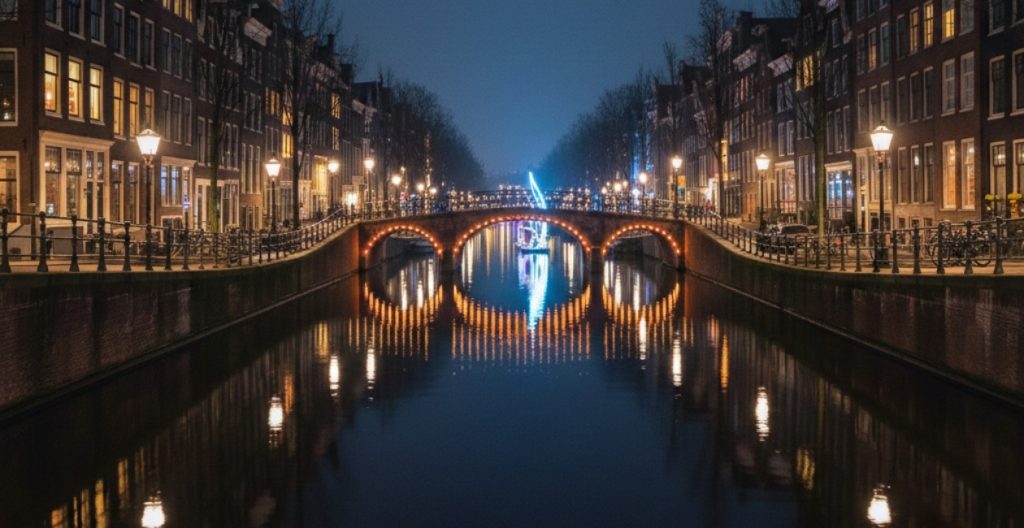
The Amsterdam Light Festival should definitely be on your travel itinerary if you’re thinking about visiting Europe in the winter. The city becomes an outdoor art gallery every year from late November to mid-January, complete with interactive artworks, light sculptures, glowing installations, and enchanted reflections on the canals. The festival has a dreamy and cinematic vibe. It is ideal for winter enthusiasts, whether you explore it on foot or by canal cruise. To help you enjoy the festival like a pro, this guide covers the precise routes, ticket types, best experiences, local advice, and travel planning. Key Takeaways: Every year, the Amsterdam Light Festival transforms the city into an outdoor gallery featuring 20–25 large-scale light artworks. It can be explored by boat, walking routes, or self-guided tours, each of which offers a completely distinct atmosphere and perspective. Depending on the duration, type of boat, and inclusions, tickets range from €18 to €32, depending on the boat operator. Unless you purchase an official map (€7.50) or participate in a guided walk (€15–€20), a walking route is free. The best viewing time is 5 pm – 10 pm, when reflections on the canals look magical for photography. Every year, the artwork is altered according to a theme, making each edition feel original, imaginative, and Instagram worthy. The festival routes are easily accessible if you stay close to Grachtengordel, Jordaan, Museumplein, or Nieuwmarkt. What is the Amsterdam Light Festival? The Amsterdam Light Festival (ALF) is an annual winter event. It is Europe’s most magical winter experiences.Every year in the winter, international artists create light-based artworks along the streets and canals as part of the Amsterdam Light Festival (ALF).It’s the ideal fusion of engineering, art, culture, and the famous canal charm of Amsterdam. It usually lasts 53–60 days. Features 20–25 art installations each year. Includes a theme, curated route, and interactive pieces. Best viewed by boat tours or walking routes. Attracts millions of tourists from all over the world. Amsterdam Light Festival 2025–2026 Dates & Timings Dates: End of November 2025 – Mid-January 2026 Lights On: Daily after sunset Timing: Usually 5 PM – 11 PM Special Days: Lights remain on till midnight during Christmas & New Year weekends. Best Ways to Experience the Amsterdam Light Festival There are two main ways to explore the festival: 1. Boat Route (Highly Recommended) The festival is designed to be seen from the water. Canal cruises give you the closest and clearest views. Why choose the boat tour? You pass directly under or beside installations. Warm boats = comfortable winter experience. No walking in cold winds. Audio guide included. Best for couples, families, senior travellers. Boat Tour Duration 60–75 minutes on average. Boat Tour Starting Points Most boats depart from: Amsterdam Central Station (East Side) Museumplein / Rijksmuseum area Amsterdam Amstel area 2. Walking Route (Budget-Friendly) A self-guided walking route lets you enjoy the installations at your own pace. Why choose the walking route? Free (if self-guided). Perfect for photographers. Lets you enjoy small cafés, Christmas markets, and canal views. You can explore narrow bridges and alleys the boats don’t access. Walking route time: 1.5 to 2.5 hours depending on pace. Amsterdam Light Festival Walking Route (Step-by-Step Itinerary) The route usually changes every year, but the general path follows Amsterdam’s historic canal belt. Here’s the most widely used route outline: Start Point: Oosterdok (Opposite NEMO Science Museum) This is where many installations begin. The waterfront area glows beautifully at night, with reflections dancing on the calm water. What you’ll see here: Large-scale sculptures Intro light installation Boats lined up for cruises City skyline lights Stop 2: Maritime Museum Bridge A picturesque arch bridge with beautiful festival visuals. What to expect: One of the most photographed installations Reflections in water Great for wide-angle shots Stop 3: Entrepotdok Canal A quiet, narrow canal with light artworks stretching between the buildings. Highlights: Suspended installations Moving light artwork Silent, peaceful ambiance Stop 4: Nieuwe Herengracht This area often hosts the biggest centerpiece artwork. You’ll find: Large interactive installations Color-changing light structures Drone-friendly area (follow local rules) Stop 5: Amstel River One of the most iconic sections of Amsterdam. What makes it special: Open water space = huge installations Photo-friendly bridges Stop for mulled wine or hot chocolate nearby Stop 6: Hermitage Museum / Magere Brug (Skinny Bridge) This glowing white wooden bridge becomes stunning under festival lighting. Perfect for: Couple photos Drone photography (where permitted) Slow walking + nighttime river views End Point: Stopera (City Hall & Opera House) The final part usually features immersive or message-based installations. Amsterdam Light Festival Tickets (Complete Breakdown) Boat Tour Tickets Average price: €22 – €29 (standard tourist boats) €35 – €45 (luxury heated boats) €50+ (private boat or small group tours) What’s included: Entry to water route Guided audio commentary Blankets on some boats Hot chocolate or drinks (depending on provider) Walking Route Tickets (Optional) You can walk the festival for free, but they also sell: Official Walking Map (€7–€10) Audio Guide App (€5–€8) Where to Book Tickets Book from: Official Amsterdam Light Festival website City boat companies: Blue Boat Lovers Canal Cruises Stromma Tours & activities platforms: GetYourGuide Viator Tiqets Pro Tip: Book at least 2–6 days earlier. As weekend cruises sell out fast. How to Reach the Festival Route From Amsterdam Central Station: Walk 5–10 minutes to the starting point Or take tram 26 or 14 From Schiphol Airport: Train to Amsterdam Central (15–20 minutes) Then walk or take a tram Food & Café Stops Along the Route Here are popular (and cozy!) winter stops: Café de Sluyswacht — Canal-view drinks Puccini Bomboni — Chocolates Bakers & Roasters — Amazing cakes Hannekes Boom — Wooden, rustic, waterfront Café de Plantage — Warm-lit, aesthetic Pro Tips to Experience the Festival Perfectly Wear warm layers .Amsterdam winds can feel icy. Carry gloves (your phone gets cold too!). Choose weekday evenings for fewer crowds. Take the boat route first, then the walking route. Carry a power bank — photos will drain the
Best winter destinations in India for couples and families
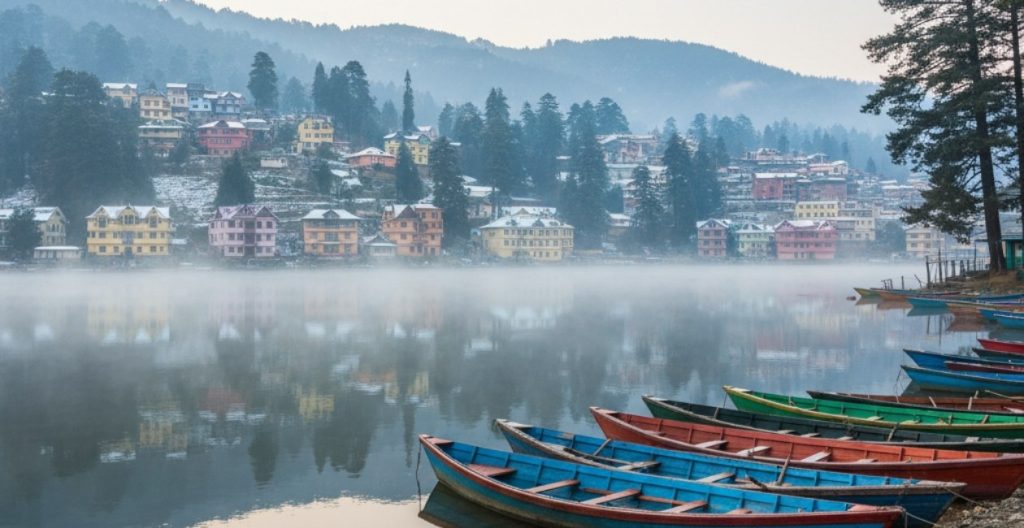
The winter season brings winter landscapes in India to life, with postcard landscapes of snow-clad peaks, misty yet lush pine dotted valleys, glistening lakes, bustling hill towns, and the warm interiors of cozy lodgings. It is the ideal time to travel with someone you love, or for a family winter break to experience some of India’s best destinations with great comfort, sights, activities, quietness or simply spend time together and share experiences. From the pristine powder of Gulmarg to the colonial splendour of Shimla to the tranquil lakes at Nainital to the best ski resorts at Auli, whatever the destination, there is always something to explore and enjoy. For couples – quiet mountain mornings, warm cabin interiors at suitable times, and stargazing strolls around the lodgings at night, should bring fond memories. Families should make winter memories by playing in the snow, conducting picturesque drives, and winter activities wherever they go! KEY TAKEAWAYS Best romantic winter destinations: Gulmarg, Manali–Solang, Shimla, Auli Best family-friendly spots: Pahalgam, Nainital, Mussoorie, Auli Best snow experiences: Gulmarg (skiing), Auli (ski slopes), Manali (adventure), Sonamarg (sledging) Warm winter getaways: Udaipur, Jaipur, Coorg (optional later sections) Top budget-friendly options: Dhanaulti, Kufri, Chopta, Patnitop Best time for snowfall: Late December to mid-February BEST ROMANTIC WINTER DESTINATIONS Beautifully curated destinations ideal for honeymooners, slow travellers, and couples seeking intimacy, privacy, and magical winter landscapes. 1. Gulmarg – India’s Most Romantic Snow Destination Gulmarg’s soft snow, forested hills draped in pine, and quiet luxury accommodation make it one of the most romantic winter destinations in India. Picture being cozy in a wooden chalet, sipping hot chocolate while flakes of snow tumble outside, the ideal atmosphere for winter romance. Why Couples Love Gulmarg Beautiful private cabins and boutique resorts Gondola rides offering surreal views of the Himalayas Quiet, scenic landscapes perfect for long walks One of India’s best places to experience real, deep snow Romantic Things to Do Gondola ride to Apharwat Peak Skiing & snowboarding Candlelight dinners with mountain views Sleigh rides through snowy meadows Best Time: Late December – MarchIdeal For: Honeymooners, couples seeking privacy, adventure-loving couples 2. Manali & Solang Valley – Romance + Adventure A winter favourite, Manali blends adventure with charm – perfect for couples who want cosy cafés, snowy landscapes, and activities like paragliding and skiing. Why Manali Works for Couples Snowy roads and pine forests Warm, café-filled Old Manali Hot springs in Vashisht Close access to Solang Valley for winter sports Romantic Experiences Café-hopping in Old Manali Private riverside resorts Skiing in Solang Drive to Atal Tunnel for fresh snow Explore: ✔ Ultimate Manali Experience ✔ Delhi to Manali Road Trip ✔ Manali Travel Guide 3. Shimla & Kufri – Colonial Romance Meets Snowy Playgrounds Perfect for couples seeking a mild, relaxed winter holiday. Shimla offers colonial charm, cafés, and Mall Road strolls, while Kufri brings snow adventures and pretty hilltop views. Why Couples Choose Shimla–Kufri Beautiful hotels with panoramic valley views Winter carnival, festive vibes Scenic toy train journey Snow activities in Kufri Romantic Experiences Ridge & Mall Road walks Ice skating at Shimla’s rink Kufri snow park Sunset views at Mashobra Also check out: ✔ How to Plan a Trip to Shimla Winter Carnival BEST FAMILY-FRIENDLY WINTER DESTINATIONS Safe, comfortable, activity-rich destinations perfect for families with kids, elderly travellers, or multigenerational trips. 1. Pahalgam – Comfortable, Scenic & Peaceful Pahalgam offers gentle slopes, easy snow access, and safe winter conditions – ideal for kids and families. Why Families Prefer Pahalgam Safe winter terrain Kid-friendly snow play areas Beautiful meadows for picnics Calm, crowd-free atmosphere Activities for Families Sledging Snow walks Short treks Aru Valley snow views 2. Auli – Skiing & Snow Fun for All Ages Auli is one of India’s best winter destinations for both families and couples. Wide slopes, training instructors, and panoramic views make it unforgettable. Family Highlights India’s best beginner-friendly skiing slopes Snow cable car rides Safe, open snowfields Great for Kids Snow play zones Ski lessons Friendly instructors 3. Nainital – Lakeside Calm & Gentle Snow A relaxing winter destination perfect for families wanting mild snow and easy travel. Why Nainital Works for Families Easy accessibility Lake views + mild winter snow Lots of kid-friendly attractions Short drives to snowfall points (Snow View, Pangot) Best For: Families with kids, elderly travellers, beginners 4. Kashmir – Romance, Snow & Family Warmth (Gulmarg • Pahalgam • Sonamarg) Kashmir remains one of the best winter destinations in India for couples and families, especially if you’re dreaming of snowfall, pine forests, frozen rivers, and cozy stays with breathtaking views. 4.1 Gulmarg – Perfect for Romantic Snow & Family Adventures Gulmarg transforms into a winter fairytale between December and March. Powder-white slopes, the iconic Gulmarg Gondola, and soft snowfall make it one of the most romantic snowfall destinations in India and a thrilling escape for families. Why couples love it: Candle-lit views of snow-draped meadows Gondola rides to Apharwat Peak Cozy cottages with fireplaces Why families love it: Beginner-friendly skiing Safe snow play zones Plenty of warm cafés and easy-access stays Best For: romance, skiing, family snow fun Keywords used: Gulmarg winter holiday, romantic winter destinations India, family winter destinations India. 4.2 Pahalgam – Peaceful Stays, Gorgeous Valleys & Family-Friendly Walks If you’re looking for a quieter winter getaway in India, Pahalgam strikes the perfect balance of beauty and calm. Couples get Instagram-worthy backdrops, while families enjoy relaxed activities suited for all ages. What makes it special: Betab Valley covered in glittering snow Riverside walks with mountain views Horses, sledges, and scenic winter photography Perfect For: couples who want peaceful winter retreats + families with kids or elders. 4.3 Sonamarg – Dramatic Snow Landscapes for Adventure-Loving Couples Sonamarg offers towering mountains, frozen lakes, and cinematic scenery. It’s ideal for couples looking for unique winter experiences and families who enjoy snow adventures. Top highlights: Snow-covered Thajiwas Glacier Sledging trails Wide-open meadows for snow play Best For: photography couples, adventure families. 5. Sikkim – Picture-Perfect Winter Escapes (Lachung, Lachen & Yumthang Valley) Sikkim
How to Plan a Trip to Shimla Winter Carnival from Delhi
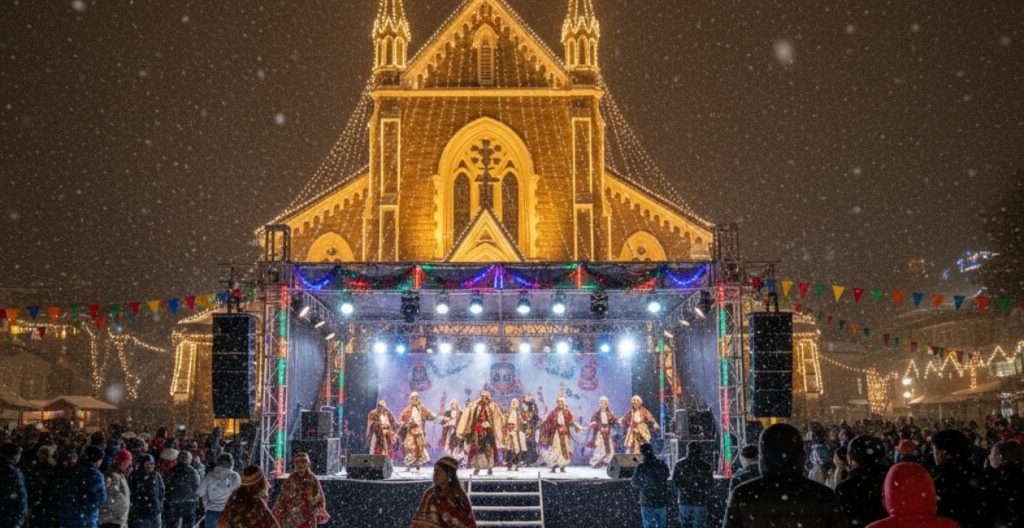
If you have ever envisioned wintertime that features snow-laden streets, jubilant celebrations, and an energetic mountainous ambiance, then you must consider attending the Shimla Winter Carnival at the top of your travel agenda. Every January, the geographical and cultural capital of Himachal Pradesh welcomes visitors from Delhi and across the country. The Street comes alive to host new snowfall, cultural activities, dance performances and traditional festivities – it is one of the most exhilarating wintertime festivals in Himachal Pradesh, and if you have the opportunity to experience it, you should not miss it! However, attempting to make a trip to/from Delhi to attend the Shimla Winter Carnival necessitates preparation – traveling with various weather/transportation/accommodation options assists with things to consider, and missing out on key dates and timeframes to travel in January to get there. The purpose of this post is to walk through everything you will need to know about the Shimla Winter Carnival, such as what it is, key dates, and when are the best times to attend the festivities as a visitor in the snowfall season. The Tarzan Way will make your Shimla trip easier and less stressful with AI based personalized itinerary planning. Quick Summary Best month: January (peak winter + high chance of snowfall) Shimla Winter Carnival 2025: Early–Mid January (final dates to be announced) Top events: Folk dances, music concerts, ice skating shows, fashion shows, food stalls Best route from Delhi: Road or Volvo bus for direct access Ideal trip duration: 3 days Weather: –2°C to 7°C, expect snow at night or after a snowfall spell Who should visit: Families, couples, photographers, snow lovers Quick itinerary: Day 1 – Delhi to Shimla, Mall Road Day 2 – Carnival events + Kufri snow Day 3 – Local sightseeing, return Estimated budget: ₹6,000–₹15,000 depending on stay & transport What Is the Shimla Winter Carnival? The Shimla Winter Carnival is an annual winter festival that celebrates Himachal Pradesh’s culture, art, traditions, and the winter beauty of the region. The Carnival coincides with the peak of winter, especially when Shimla is covered in snow and adds an enchanting charm to the entire celebration. Why the Carnival is famous It combines culture, food, adventure, and snow in one event. Tourists enjoy Shimla at its most picturesque—blanketed in white snow. Major events take place around The Ridge, Mall Road, and Lakkar Bazaar, making it easy to explore on foot. It highlights Himachali culture through dance, handicrafts, and food stalls. Who should attend Families looking for a winter holiday Couples wanting a romantic snowy getaway Solo travellers and backpackers Snow lovers & photographers Festival enthusiasts In short, the Carnival brings winter alive with fun, colour, and culture, making it a top pick for travellers from Delhi every year. Shimla Winter Carnival 2025 Dates, Events & Highlights While official dates for Shimla Winter Carnival 2025 are typically announced closer to December, the festival historically takes place in the first or second week of January. Expected Dates for 2025 First Week of January – Mid January 2025 (Once government notifications are out, you can update this section.) Main Event Locations The Ridge – cultural shows, inaugural ceremony Mall Road – food stalls, shopping, live music Lakkar Bazaar – souvenirs, local crafts Ice Skating Rink near Lakkar Bazaar – winter sports events Major Events to Expect 1. Cultural Dance & Music Shows Himachali folk dances like Nati, Gaddi, and Kinnauri performances attract huge crowds. 2. Ice Skating Events Shimla boasts one of the oldest open-air ice skating rinks in Asia. Expect: Ice skating competitions Figure skating displays Beginner lessons 3. Fashion Shows & Talent Competitions Local artists and youth showcase modern and traditional styles. 4. Food Stalls & Himachali Cuisine Try: Siddu Babru Thukpa Momos Local hot beverages Winter sweets 5. Adventure Activities In and around Shimla, especially at Kufri, you can enjoy: Skiing Tobogganing Snow-walking Short treks 6. Photography & Art Stalls Carnival corners dedicated to local painters and photographers showcase Himachal’s landscapes and culture. Why These Events Matter for Travelers They offer a deep cultural immersion. Most activities are free or low-cost. Everything takes place in central Shimla, making navigation easy. The Carnival atmosphere is lively, vibrant, and perfect for winter travel. Explore Best Winter Adventure Destinations in India for Snow Lovers to plan your winter activities itinerary. Best Time to Visit Shimla Winter Carnival (Snowfall Season Guide) One of the biggest reasons Delhi travelers visit Shimla in January is the chance of experiencing live snowfall. When does Shimla get snowfall? Late December Early January Mid January These weeks are historically the most snow-heavy in Shimla. Temperature in January Day: 4°C to 7°C Night: –2°C to 2°C Cold waves and icy winds are common. Snowfall Conditions in Carnival Week Snowfall usually depends on weather patterns, but typically: After a western disturbance, Shimla often sees moderate snowfall. Kufri and Mashobra frequently see heavier snow than Shimla town. Best Days to Attend the Carnival Early mornings: Less crowd Evenings: Best for lights, music, and longer events Weekdays: Less crowded than weekends Peak vs Off-Peak Visit Time Pros Cons Early January High snowfall chance, coldest, best photos Max crowd, higher hotel rates Mid January Fewer tourists, still winter charm Slightly lower snowfall chances If You Want Snowfall Guarantee Visit: Kufri, Mashobra, or Narkanda (1–2 hrs from Shimla). Even during low-snowfall weeks in Shimla town, these areas usually stay snow-covered. Why This Is the Best Time for Delhi Travelers Perfect winter escape from Delhi’s foggy plains Carnival + snowfall = ideal holiday combo Scenic winter drives and mountain sunrises Cooler, fresher air compared to Delhi’s harsh winter pollution How to Reach Shimla Winter Carnival from Delhi (Complete Transport Guide) Travelling from Delhi to Shimla during winter is exciting but requires planning due to snowfall, fog, and traffic near festival venues. Here are all the travel options—road, bus, train, and flight—explained with winter-specific details. Delhi to Shimla by Road (Winter Road Trip) A road trip is one of the most popular ways to reach Shimla for
Best Winter Adventure Destinations in India for Snow Lovers
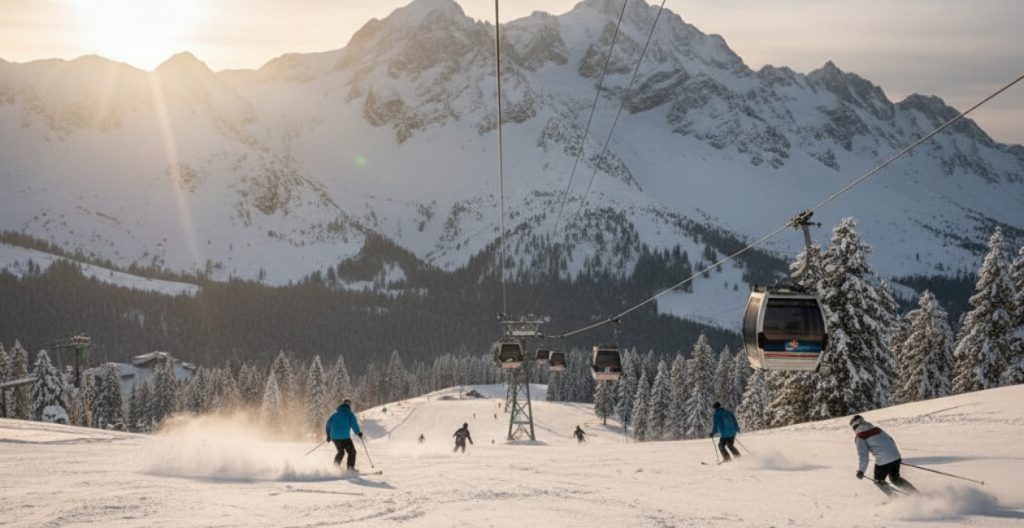
If you enjoy snow-covered landscapes, fresh winter air, and the excitement of adventure, India can be a fairytale playground from December to February. From skiing over fresh powder to winter trekking over frozen valleys, India has many of the best winter adventure destinations for snow lovers regardless of experience level – you may be a first-time snow traveler or a much more experienced traveler and just need to acclimatize to heights as you’ve already done low-altitude snow travel. Winter travel in India has grown rapidly and with it, the demand for snow destinations, winter adventure travel, and off-the-beaten-path snowy escapes. This guide outlines India’s favorite winter adventure destinations, what winter adventure experiences they provide, the best time of the year to visit, and what to consider when planning that special winter holiday. This blog will help you choose your winter getaway, whether you want to ski in Kashmir, camp in Spiti, trek in Uttarakhand or participate in family-friendly snowfall and sightseeing in Himachal. In Short India has some of the best winter destinations for snow lovers between December and February. Ideal for skiing, snow trekking, snow camping, sledging, winter photography, and more. Best regions: Jammu & Kashmir, Himachal Pradesh, Uttarakhand, Sikkim, and Arunachal Pradesh. Perfect for families, adventurers, honeymooners, and budget travelers. Top Snow Destinations in India 1. Gulmarg – India’s Winter Adventure Capital Gulmarg remains the ultimate destination for snow lovers and thrill-seekers. Known for its world-class skiing terrain and powder snow, it attracts both beginners and professional skiers from around the world. Why Visit Gulmarg? One of Asia’s best skiing destinations Home to the famous Gulmarg Gondola, one of the world’s highest cable cars Consistent heavy snowfall from December to March Stunning winter landscapes for photography Winter Adventures: Skiing & snowboarding Gondola ride to Apharwat Peak Snow trekking Snowmobile rides Sledging Best Time: Late December – March Who Is It For? Adventure seekers, photographers, couples. 2. Sonamarg – Frozen Wonderland of Kashmir Sonamarg transforms into a sparkling winter paradise during snowfall. Its frozen rivers, white meadows, and towering peaks make it one of the most enchanting winter destinations in India. Why Visit Sonamarg? Mesmerizing snow-covered valleys Less crowded than Gulmarg, perfect for peaceful winter travel Dreamlike landscapes ideal for film-style photography Gateway to Thajiwas Glacier winter trek Winter Adventures: Snow trekking to Thajiwas Glacier Snowmobile rides Sledging on soft snow slopes Frozen lake walks Best Time: December – March Who Is It For? Nature lovers, families, offbeat snow travelers. 3. Pahalgam – Family-Friendly Snow Destination Pahalgam is known for its gentle snow-covered meadows, pine forests, and riverside winter charm. It offers the perfect balance between adventure and relaxation. Why Visit Pahalgam? Safe and scenic for families and kids Soft, powdery snow perfect for beginners Beautiful winter views of Betaab Valley and Aru Valley Ideal for peaceful snow holidays Winter Adventures: Sledging & snow play Snow hikes in Aru Valley Pony rides through snowy forests Riverside winter walks Best Time: December – February Who Is It For? Families, couples, leisure travelers. 4. Manali & Solang Valley – Adventure Hub of Himachal Manali and Solang Valley transform into bustling winter adventure hubs every year. These destinations are ideal for first-time snow travelers and thrill-seekers alike. Why Visit Manali & Solang? Endless snow activities for all ages Famous for accessible adventure sports Snowy mountain views without long travel Perfect for winter road trips Winter Adventures: Skiing & snowboarding (Solang Valley) ATV & snowmobile rides Paragliding over snow-covered valleys Snow tubing, zorbing, and ropeway rides Best Time: December – February Who Is It For? Families, groups, adventure beginners. 5. Spiti Valley – Raw, Rugged & Only for the Brave Winter in Spiti is not for everyone. With frozen rivers, sub-zero temperatures, and dramatic landscapes, this is the ultimate test of adventure and resilience. Why Visit Spiti Valley? One of India’s most extreme winter destinations Lunar-like white landscapes Chance to spot the elusive snow leopard Authentic local hospitality in remote villages Winter Adventures: Winter treks across frozen terrain Monastery visits (Ki, Tabo) Snow leopard tracking Frozen river walks Best Time: January – March Who Is It For? Hardcore adventurers, photographers, wildlife enthusiasts. 6. Kalpa & Sangla – Himalayan Villages Wrapped in Snow Kalpa and Sangla offer peaceful, postcard-perfect winter escapes. Snow-covered apple orchards, old wooden houses, and quiet valleys make them magical. Why Visit Kalpa & Sangla? Stunning views of Kinnaur Kailash Untouched snow villages with minimal tourism Old-world charm and wooden architecture Clear skies perfect for sunrise and stargazing Winter Adventures: Snow village walks Winter hiking Local food & homestay experiences Photography of snow-covered orchards Best Time: December – February Who Is It For? Slow travelers, couples, culture lovers. 7. Auli – India’s Skiing Paradise Auli is India’s most popular skiing destination, known for its perfectly groomed slopes and panoramic Himalayan views. Why Visit Auli? One of India’s best places to learn skiing Breathtaking views of Nanda Devi and surrounding peaks Smooth slopes ideal for beginners Perfect combination of snow, adventure & scenery Winter Adventures: Skiing (beginner + professional courses) Chairlift & gondola rides Snow trekking Snow camping nearby Best Time: Late December – February Who Is It For? Beginner skiers, families, snow lovers. 8. Chopta–Tungnath–Chandrashila – Winter Trekking Heaven This region offers one of the most rewarding winter treks in India, famous for its snowy forests and summit views. Why Visit Chopta–Tungnath–Chandrashila? Known as India’s “Mini Switzerland” Easy-to-moderate trek even in winter Breathtaking 360° Himalayan summit view from Chandrashila Snow-covered forests and old temples Winter Adventures: Tungnath Temple snow trek Chandrashila summit climb Snow camping Wildlife spotting along the trail Best Time: December – February Who Is It For? Trekking enthusiasts, backpackers, adventure groups. 9. Mukteshwar – Snowy Forests & Tranquil Escapes Mukteshwar offers a quiet, serene winter escape surrounded by pine forests and mountain views. It’s ideal for slow travel and peaceful snow experiences. Why Visit Mukteshwar? Quiet alternative to crowded hill stations Beautiful forest trails dusted with snow Charming cafes, cottages, and nature stays Views of Trishul,
AI-Powered Travel Experiences: The Future of Smart Tourism and Intelligent Itineraries

Introduction – The Dawn of AI-Powered Travel The world of travel is changing more rapidly than at any point in history. Whether it is a spontaneous weekend trip, or an excursion on another continent, today’s travelers desire something more than a simple checklist – they are looking for connection, personalization and meaning. At the core of today’s shift is AI powered travel – technology infused with emotion which creates journeys that often feel human in their humanity. We are officially in the age of smart tourism – a social movement that is transforming travel into an intelligent, data driven, and profoundly immersive experience. Rather than the old-fashioned approach to trip planning, smart tourism utilizes AI travel tech to predict interests, optimize itineraries, and personalize every part of your journey down to the moment you begin searching for your next trip, to the stories you share when you arrive home. This transformation is being led by a wave of travel-tech startups in India that are combining artificial intelligence with stories of culture. The Tarzan Way (TTW), a travel platform that is reimagining intelligent travel planning by combining automation with authenticity, is a leading innovator in this space. At TTW, the belief is simple yet revolutionary: “AI can make travel smarter, but it should never take away the human essence of discovery.” Using AI-driven tools and community-led narrative, The Tarzan Way brings the gap between tech and human, creating itineraries that are smart and soulful – analytical and yet very human. Today in tourism, AI tools aren’t just a buzzword, but a true paradigm shift that’s shaping the way the next generation will explore the world. Let’s explore what this shift looks like – and how The Tarzan Way is activating the AI travel revolution, one smart itinerary at a time. Check out our deep dive: AI Travel Planner: How Artificial Intelligence Is Changing Trip Planning Key Takeaways For those who like to skip ahead, here’s a quick summary of the future of AI-powered travel ✅ AI-powered travel is transforming how we plan and experience trips – using data and automation to design meaningful, personalized journeys. ✅ Smart tourism emphasizes connection, sustainability, and personalization – going beyond convenience to create emotional travel experiences. ✅ The Tarzan Way is a frontrunner in blending AI intelligence with human insight, crafting intelligent travel planning experiences tailored to every traveler’s vibe. ✅ Predictive travel technology and machine learning are making itineraries dynamic, adjusting routes, timing, and activities in real-time. ✅ The future of travel will be immersive, sustainable, and powered by empathy – where AI acts as your creative co-traveler, not a cold algorithm. What Smart Tourism Means in 2025 Smart tourism is not a concept for the future-it is happening right now. In 2025, smart tourism involves innovation, sustainability and personalization. It is about enabling AI and data analytics to promote travelers’ journey at every stage. What if you were to: search for “a quiet coastal retreat” on your phone, and an AI-based itinerary planner provided you not only with scenic seaside towns but also with destination suggestions that reflect your personality, whether you are a quiet writer in search of solitude or a digital nomad seeking Wi-Fi and a wave. That’s AI-driven travel at its best-predictive, personal, and above all, human. The Evolution of Smart Tourism In the early 2010s, the technology for travel was measured largely by its transactional quality – booking tickets, reserving a hotel, or comparing prices. Then, as we reached 2020, personalization emerged as the next great frontier. Platforms began making tailored suggestions based on behavioral markers. Now, here we are in 2025, and we are in a new era of intelligent travel planning. The system is now not only reactive, but predictive. AI greatly enhances the opportunity for personalization, as it can analyze substantial amounts of traveler data-preferences, reviews, and even social media sentiment-to curate trips that feel like a tailored experience. This is not just about convenience, it is about curating experiences that enhance the emotional and intentional activity of belonging to the place in question. Smart Tourism and Sustainability Sustainability is yet another pillar key to smart tourism in 2025. AI can avert over-tourism by directing travelers to less-travelled destinations, reducing energy use in hotels and other accommodations, and cultivating local economies via curated local experiences. By merging data-based travel experiences with sustainable smart tourism, startups like The Tarzan Way show that ingenuity can be purpose-driven, as “smart tourism is not about technology replacing intuition. Smart tourism connects us by creating experiences around people with intelligent algorithms and personalization”. Smart tourism is not about “where to go” – it’s about why to go there and the experience of travelling together. Data-Driven and Predictive Travel Experiences If smart tourism is the soul of future travel, data is its heartbeat. Every choice a traveler makes – the kind of destinations they prefer, how long they stay, what foods they love, and even when they decide to travel – generates valuable insights. When analyzed with AI, these insights turn into predictive travel technology that anticipates what travelers will want before they even search for it. This is what we call data-driven travel experiences – journeys shaped by patterns, powered by personalization, and perfected by prediction. The Shift from Reactive to Predictive Travel Traditional travel platforms worked reactively. You searched for destinations, compared hotels, and manually built itineraries. Now, AI in tourism goes a step further. By analyzing your search intent, social media sentiment, weather trends, and global events, it predicts your next move. Planning a spiritual trip? AI tools recommend destinations like Bhutan or Bali during calmer, off-peak months. Prefer adventure? Predictive models suggest spots like New Zealand or Peru when conditions are ideal for hiking or skydiving. Traveling for mindfulness? AI curates wellness itineraries blending meditation, local healing practices, and sustainable stays. This is intelligent travel planning – transforming passive browsing into active personalization. “In predictive travel, you don’t plan your journey. Your journey plans itself for you.”
AI Travel Planner: How Artificial Intelligence Is Changing Trip Planning | The Tarzan Way

When we founded The Tarzan Way (TTW) in 2018,travel packages were never our only objective, our goal was to create something more profound.A bridge connecting people and locations, a means of giving travel purpose, authenticity, and effortless personalization. However, as the travel industry evolved, we realized that although technology speeds up bookings and reduces the cost of flights. But on the other hand it also makes the trip planning tiresome. Before you’ve even packed your bags, you’ve already seen dozens of tabs, contradicting reviews, and countless comparisons. We thought, “What if organizing a trip could be as easy as talking to a friend who really understands you?” We have previously used advanced AI models integrated into our platform to craft seamless end-to-end travel experiences, helping users plan, book, and enjoy their trips effortlessly. Our system intelligently analyzed traveler preferences, behaviors, and contexts to curate trips that matched their unique interests and needs. Now, taking this innovation a step further, we are introducing “Kaira”, the next evolution in intelligent travel solutions. Kaira does not just plan trips; it understands the traveler. By interpreting moods, emotions, and intent, Kaira personalizes every aspect of the journey, suggesting destinations, activities, and experiences that truly resonate with how the traveler feels. This makes travel not only smarter but also deeply personal and emotionally aware. Prior to revealing how we created her and her capabilities. Let’s examine how artificial intelligence is transforming travel planning and how we at TTW are leading that change. Key Takeaways AI-powered trip planners,such as Kaira,reduce complicated planning.Transform it into simple and conversational steps. In no time,using data and reasoning,the AI travel planners can customize itineraries, budgets, and experiences. At The Tarzan Way,with the fusion of AI technology with human empathy, we make travel planning simple and fulfilling by fusing AI technology with human empathy. Humans are not replaced by AI. It improves personalization, increases creativity, and saves time. TTW’s mission remains clear: to use technology to make travel more convenient, responsible, and genuine while staying true to its core values. What Is an AI Travel Planner? To put it simply, an AI travel planner is a digital tool that assists travelers in automatically designing their trips by utilizing artificial intelligence. Artificial intelligence trip planners examine millions of data points, including prices, reviews, travel times, and weather forecasts, to create a comprehensive itinerary based on your preferences, eliminating the need for manual flight, hotel, or attraction searches. Contextual understanding, however, is what makes them truly revolutionary.When you say, “I want a peaceful getaway,” AI can understand that you’re not looking for a crowded city.As an alternative, it might suggest mountain retreats or homestays by lakes. Our goal in developing Kaira was precisely that: an AI that does more than just process data; it reads between the lines, senses your vibe, and creates a journey that genuinely feels you. How AI Automates Itinerary Creation & Budgeting Traditionally, trip planning used to involve hours of manual searching.You would look at several websites for airfare offers, evaluate hotels, read reviews, and still question if this is the best choice. Here is how AI completely changes the traditional approach: Instant Itinerary Building: AI programs such as Kaira can generate a comprehensive travel itinerary in a matter of seconds. Complete with daily itineraries, suggested activities, transportation routes, and meal breaks.It goes with the mood of the traveler from calm to cultural to nightlife, you chose your vibe and the Ai delivers. Smart Budgeting: AI continuously monitors current prices and makes recommendations for changes to keep your plan within your means. Time Optimization: It eliminates irrational plans (such as attempting to visit too many locations in a single day). It generates sensible routes. Dynamic Adjustments: Is the flight delayed?Did the weather change?AI can update your plan instantly, preventing chaos and stress. For example, if rain is predicted, Kaira may recommend moving your beach day earlier or replacing a lengthy road trip with a short internal flight.It’s similar to having an attentive personal assistant who’s always one step ahead The Human Touch in Artificial Intelligence It has always been our belief at The Tarzan Way that travel is as much an emotional experience as it is a practical one. AI is capable of analyzing data, but empathy is what transforms data into knowledge. Because of this, we didn’t want Kaira to come across as transactional or robotic. We created her to feel like a human—kind, funny, and compassionate. If you plan a Europe trip on a tight budget, she could gently remark, “Hmm… Europe might be a stretch under ₹30,000, but have you thought about Vietnam or Georgia instead?” She leads you with humor and warmth, not just correcting you. Real innovation, in our opinion, starts with this fusion of human sensitivity and AI intelligence. Pros & Cons of Using AI for Travel Artificial Intelligence travel has advantages and disadvantages, just like any other technology.Let’s honestly consider both sides. Pros Speed:Construct whole itineraries in a matter of seconds. Personalization:Each plan is tailored to your goals, budget, and travel preferences. Data-Driven Insights:AI instantly verifies current travel information, reviews, and prices. Efficiency: You can stop worrying about missed deals and juggling tabs. Cons Lack of Emotional Nuance: Despite Kaira’s best efforts, not all AIs are able to comprehend your emotions or mood. Limited Local Context:Undiscovered local gems may be missed by purely digital tools. Dependence on Tech:Travelers need to maintain an internet connection. But we have a solution for this too. Our team of travel curators adds human stories, local insights, and cultural authenticity to the data we handle with AI for accurate and better results. How Our System Creates Seamless Travel Experiences (before “Kiara”) Before introducing Kaira, we at The Tarzan Way were already using our own advanced system to design and deliver complete travel experiences from discovery to execution. Our system is designed to understand every traveler’s needs and automatically build end-to-end trips that include everything from destinations, stays, transport, activities, recommendations, to even local insights. We’ve



